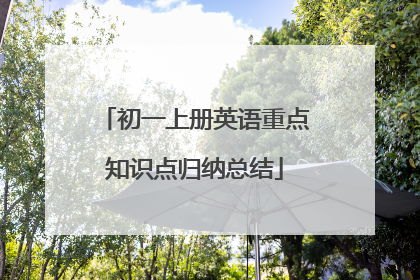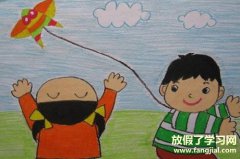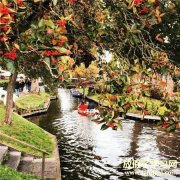初一上册英语知识点总结
初一上册英语语法知识 have/ has的用法: 1) 谓语动词have表示“有”,有两种形式:have和has,前者用于第一人称(I, we),第二人称(you)和第三人称复数(they),后者用于第三人称单数(he, she, it)或单数名词。 I have an apple and he has two bananas. 我有一个苹果,他有两个香蕉。 You have a new English teacher. 你们有了一个新的英语老师。 It has two big eyes. 它有一双大眼睛。 Julie and Jack have a nice car. 朱莉和杰克有一辆好看的车。 2) have/has句型与there be句型的比较:两者都表示“有”,但用法不同。前者表示所属关系,即表示“某人或某物有什么”,而后者表示存在,表示“某地有什么”。 They have some new books. 他们有一些新书。 There are some new books on their desks. 他们桌子上有一些新书。 She has a lot of pretty skirts. 她有很多漂亮的`裙子。 There are a lot of pretty skirts in the shop. 商店里有很多漂亮的裙子。 3) have/ has的否定句,一般要加助动词do/ does,再加not构成,即do not have (don’t have)/ does not have (doesn’t have). She does not have a sister. 她没有姐姐。 We don’t have any classes on Saturday. 我们星期六没有课。 Ann and I don’t have a big room. 我和安没有一个大房间。 4)一般疑问句由“助动词Do/ Does + 主语 + have + 宾语”构成,回答用Yes, „ do/ does.或者No, „ don’t/ doesn’t. --Do you have a big house? 他们的房子大吗? --No, they don’t. 不,他们的房子不大。 --Does he have an eraser? 他有橡皮吗? --Yes, he does. 他有的。 初一必备英语知识 名词的数 名词分为可数名词和不可数名词,而不可数名词它没有复数形式,但可数名词却有单数和复数之分,复数的构成如下: 一) 直接在后面加s 如:fathers, books, Americans, Germans, apples, bananas 二) x, sh, ch, s, tch后加es。 如:boxes, glasses, dresses(连衣裙), watches, wishes([wiʃ]希望、祝福), faxes(传真) 三)1)以辅音字母加y结尾的变y为i再加es 如:baby-babies, family-families, duty-duties ['dju:ti责任、职务], comedy-comedies ['kɔmidi喜剧], documentary-documentaries story-stories 2)以元音字母加y结尾的直接加s 如:day-days, boy-boys, toy-toys(玩具), key-keys, ways(方法、道路) 四)1)以o结尾加s(外来词) 如:radios, photos, 2)是辅音加o的加es: [,dɔkju'mentəri纪录片n、记录的v], 如: tomatoes西红柿, potatoes马铃薯 五)以f或fe结尾的变f为v再加es(s)。 如:knife-knives, wife-wives, half-halves, shelf-shelves [ʃelf架子、搁板], leaf-leaves(叶子), yourself-yourselves 初一英语知识 介词用法: 1)具体时间前介词用at。 He gets up at half past seven every day. 他每天七点半起床。 She goes to bed at eleven o’clock. 她十一点睡觉。 2)表示“在早上,在下午,在晚上”的短语中用介词in,且定冠词the不能省略;表示“在中午,在夜里”的短语中介词用at,不加冠词。 in the morning在早上,in the afternoon 在下午,in the evening 在晚上 at noon在中午,at night在夜里 3) 表示“在某天”、“在某天的上午、下午等”的短语用介词on。 What do you usually do on Monday morning? 星期一上午你通常做什么? Do you sometimes go out to eat on Friday evening? 有时你星期五晚上出去吃饭吗? He watches DVDs on Saturday night. 星期六晚上他看DVD。 Parents take children to parks on June 1. 六月一日,家长们带着孩子去公园。 4)在this, last, next, every等词前面既不加介词,也不用冠词。 What are you doing this afternoon? 今天下午你做什么? He visits his grandma every Friday. 他每个星期五都去看望祖母。

初一上册英语重点知识点归纳总结
对于初一的一些学生来说,初一英语很难学习,初一都学哪些知识,下面总结了一些初一英语重点知识点,希望可以给大家的学习带来帮助。 一.可数名词变复数 1.一般直接在词尾加“-s ”,如:cake-cakes, bag-bags, day-days, face-faces, orange-oranges等; 2.以s, x, sh, ch结尾的词,要在词尾加“-es ”,如:bus-buses, watch-watches, box-boxes等; 3.以辅音字母加y结尾的词,变y为i再加“-es ”,如:baby-babies, country-countries, family-families等; 4.部分以f (e)结尾的词,变f (e)为“ves ”,如:knife-knives, half-halves等; 5.以o结尾的词,加“-s ”或“-es ”,如:zoo-zoos, photo-photos, tomato-tomatoes, potato-potatoes等。记忆口诀:除非“英雄”hero外,只要能吃的,加“-es ”,不能吃的加“-s ”。 6.变换单数名词中的元音字母:man-men, woman-women, foot-feet, tooth-teeth等; 7.单、复同形:sheep-sheep, Chinese-Chinese, Japanese-Japanese等; 8.其他形式:mouse-mice, child-children等。 二.人称及人称代词的不同形式(主格和宾格) 1、三种人称:第一人称(I, we),第二人称(you, you),第三人称(he, she, it)。 2、人称代词的主格,即人称代词位于句子主语位置时的形态:I, We, You, You, He, She, It 3、人称代词的宾格,即人称代词位于句子宾语位置时的形态:me, us, you, you, him, her, it。 4、形容词性物主代词:my, our, your, your, his, her, its, their。 5、名词性物主代词:mine, ours, yours, yours, his, hers, its, theirs。 6、反身代词:myself, ourselves, yourself, yourselves, himself, herself, itself, themselves。 三. 不定冠词a / an 的用法 不定冠词a / an表示微弱的“一”的概念,但并不强调数目,只表示名词为不特定者。A用在以辅音音素开头的单词或者字母前,an用在以元音因素开头的单词或者字母前。 1.表示数量“一”。 a book 一本书 an egg 一个鸡蛋 2.笼统地指某人或者某物,但不具体说明。 There is a carin the yard. 院子里有一辆小汽车。 3.泛指某一类人或事物。 A house is a useful animal 马是有用的动物。 4.表示首次提到的人或者食物(常用语介绍用语中)。 This is a key. 这是一把钥匙。 5.表示某一类人或事物中的任何一个。 There is anelephant in the zoo. 动物园里有一头大象。 四.定冠词the的用法 The是定冠词,表示特指的人、物或群体,起作用有时相当于指示代词this, that,these, those,表示“这(个),那(个),这些,那些”。它可以用在名词前,表示特指说话双方的人或者上文中提到的人或者事物。 1.和个体名词的单数或者复数连用,表示某个(些)特定的人或事物。Give me the book.把那本书给我。 2.特指说话双方都知道的人或事物。Where is theruler?尺子在哪里? 3.指上文中提到的人或事物。This is a pen. The pen isblack.这是一支钢笔。这支钢笔是黑色的。 4.用在世界上独一无二的事物前。 the sun 太阳 the earth 地球 the moon 月亮 the world 世界 5.和某些形容词连用,表示一类人。 the old 老人 the young 年轻人 the poor 穷人 6.用在方位名词前。The east 东方 the west 西方 7.与play连用时,用在西洋乐器名词前。Play the piano弹钢琴 8.与专有名词连用。The Great Wall 长城 The SummerPalace 颐和园 9.用在一些固定短语中。In the morning / afternoon /evening 五.形容词性物主代词 物主代词是表示所有关系的代词,是人称代词的属格形式。它分第一人称、第二人称和第三人称,每个人称又分单数和复数。物主代词分形容词性物主代词和名词性物主代词。 形容词性物主代词的用法和形容词的用法相似,具有形容词的性质。在句中作定语,修饰名词,一般放在被修饰的名词前,不能单独使用。如果名词前还有其他的定语,物主代词要放在其他定语的前面。 六.介词短语 介词短语的构成:介词+the / 物主代词/名词所有格+名词等。 1.在介词短语中,定冠词the常常不翻译成中文,但the不能省略,是表示特指的。 2.若介词短语中名词前用了物主代词或名词所有格时,不能再用定冠词the,但名词所有格前可以用the。 3.专有名词前不能用the。 4.表示方位的介词:on, in, behind, between,under等。 on在……上面(紧贴着某物,有面的接触)in 在……里面;behind在……后面;between在……之间,常于and连用;under在……的下面。

七上英语知识点总结
七上英语知识点总结 英语对于学生们有一定的难度,但只要掌握好相关的语法就不用太担心。下面七上英语知识点总结是我为大家带来的,希望对大家有所帮助。 七上英语知识点总结 Unit1. My name’s Gina. 句型:1, What’s your name? My name’s Jenny. / I’m Jenny. / Jenny. May I have your name? Yes, my name’s Jenny. What’s his/her name? His/Her name’s Tony/Gina. 2, I’m Tony Brown. What’s your full name? My full name/ It is Tony Brown. My first name is Tony. My last name/family name is Brown. 3, What’s your/his/her telephone/phone number? It’s 555-3539.语法:1,形容词性物主代词:my(我的) your(你的) his/her/its(他/她/它的) our(我们的) your(你们的)their(他们的) 后面需要接名词,修饰名词,做前置定语。 在句中可作主语,宾语等成分。 My book is here. This is my book. 2, 主格: I you he/she/ it we you they 在句中做主语,一般放句首,后面紧跟 am/is/are 及其他动词。 I’m a student. She looks great. Unit2. Is this your pencil? 句型:1, Is this your pencil? Yes, it is. 2, Is this my pen? No, it isn’t. 3, Is that his book? Yes, it is. 4, How do you spell it? = Can you spell it, please? = Spell it, please. 5, Call Alan at 495-3539. Call me/him/her/them. 给我/他/她/他们打电话. Call 4953539 拨打4953539。 Call sb. at + 电话号码 拨打……找某人 6, Is that your computer game in the lost and found case? 7, a set of keys a set of + 名词复数 语法;1,句中含be(am, is, are)一般疑问句的变法: 把be提前,如果句中有my变your,I 变you,其他的.照抄不变。肯定回答 yes, 主语+am/is/are 否定回答 No,主语+am not/aren’t/isn’t. 注意:回答时主语如果是物品单数或者this/that的话,用it替代主语,如果是复数人和物品用they替代。 2, be动词的用法口诀;I am, you are, is 他/她/它(he/she/it),单数is 复数are. Be动词跟随主语的变化而变化。 Unit3. This is my sister. 句型:1,Is this your sister? No, it isn’t. Is she your sister? No, she isn’t. 2,This is my friend. These are my friends. That is my brother. Those are my brothers. 3, Thanks for the photo of your family. Here is my family photo. photo of your family = your family photo 语法:可数名词单数变复数:一般情况下加s, book-books, 以s, x, sh, ch结尾的加es watch-watches 以辅音字母加y结尾的,把y改为i再加es boy- boys, family-families 以o结尾的有生命的加es, 无生命的加s, tomato-tomatoes, photo-photos unit4. Where’s my backpack? 句型:Where’s the baseball? It’s in the backpack. Where’s my computer game? It’s under the bed. Where are his keys? They’re on the dresser. Where are your books? They’re on the chair. Where are her keys? They’re on the table. Where are you? I’m at school. Is it on the dresser? No, it isn’t. Please take these things to your sister. Can you bring some things to school? The book is on the floor. 语法: 1,询问人或物品在哪里,我们用Where, 结构为 where+is/are+人/物品名称? “……在哪里”回答用 主语+is/are +in/at/under/on/near +地点 注意:表示“在……地方”地点前要用定冠词the 或者形容词性物主代词my/your/his/their修饰,但是两者不能同时出现,我们可以说in the room, in my room 但是绝对不可以in the my room. 词语用法:1, take v.带走, 把人或物品带到别的地方去,take …to… 把……带到……去 bring v.带来,把人或物品从别的地方带到说话的地方来 bring…to… 把……带到……来 2,please 后接动词用原形。 unit5. Do you have a soccer ball? 句型: Do you have a TV? Yes, I do/No, I don’t. Do they have a computer? Yes, they do./No, they don’t. Does he have a tennis racket? Yes, he does./No, he doesn’t. Does she have a soccer ball? Yes, she does./No, she doesn’t. Does he have a ping-pang ball? Yes, he does./No, he doesn’t. Let’s play soccer. Let me help you. I don’t have a soccer ball. That sounds good. 语法:1,句中不含be(am,is,are)动词的 一般疑问句的变法。 也就是说句中谓语动词是实义动词时,要变为一般疑问句,在句首加do/does(当主语是第三人称单数的时候用does),第一人称变第二人称,动词变原形其他的语序不变。I have a computer. – Do you have a computer? She likes playing ping-pang.- Does she like playing ping-pang.肯定回答用yes, 主语+do/does.否定回答用No,主语+don’t/doesn’t. 2一般句子中当主语是第三人称单数的时候,谓语动词要起变化。具体的变化为:一般情况加s, know-knows, 以s,x,ch,sh,o结尾的加es, teach-teaches, go-goes, 以辅音字母加y结尾,把y改为i,再加es study-studies 3, do/does 叫做助动词(语法需要加上去翻译部出来的动词)时,后面接动词原形, Does he like reading? She doesn’t like reading. She doesn’t do her homework. 但是如果做实义动词(能翻译出来意思的动词)呢,遇到主语第三人称单数就要起变化。 She does her homework. 4,have的第三人称单数为 has. 5, let sb do sth 让某人做某事 (sb代表人,如果是代词用宾格,do代表动词原形) 6,play+球类 表示“踢,打,玩......” play football play+the+乐器 表示“弹奏……乐器” play the piano unit6 Do you like bananas? 句型:Do you like salad? Yes, I do./No, I don’t. Does he like pears? Yes, he does./No, he doesn’t. I like oranges. I don’t like oranges. Running star eats lots of healthy food. 语法: 句中谓语动词是实义动词的陈述句,变否定形式在实义动词前加don’t\doesn’t(主语是第三人称单数时用doesn’t’). like doing sth/like to do sth 喜欢做某事 I like swimming. She likes to eat hamburgers. Unit7 How much are these pants? 句型:How much is the red sweater? It’s eight dollars. What’s the price of the red sweater? It’s eight dollars. How much are these black pants? They’re ten dollars. What’s the price of these black pants? They’re ten dollars. Can I help you?=What can I do for you? Yes, please. I want a sweater. What color do you want? Blue. Here you are. How much is it? Nine dollars. I’ll take it. Anyone can afford our prices. Come and see for yourself at Huaxing Clothes Store. We have sweaters at a very good price. You can buy socks for only $1 each. The girl in red is my friend. The green shorts are on sale for $25. 结构: 询问价格 How much + is/are + 物品名称? What’s the price of+ 物品名称? ……多少钱? 回答:It’s/They’re + 价格 Unit8 When is your birthday? 句型:When is your birthday? My birthday is November 11th. When is Liu Ping’s birthday? Her birthday is on September 5th. When is his birthday? It’s March 21st. 语法: 月份前用介词in, in May 在六月, 但是具体到某一天用介词on, on May 1st. .Unit9 Do you want to go to a movie? 句型:Do you want to go to a movie? Yes, I do./ No, I don’t. Does he want to go to a movie? Yes, he does./No, he doesn’t. What kind of movies do you like? I like action movies and comedies. I like thrillers and l like Beijing Opera. I like comedies but I don’t like documentaries. She often goes to see Chinese action movies on weekends. She thinks she can learn about Chinese history. He really likes his movies. Mike’ father likes it, too! = Mike’s father also like it. I think it’s boring/exciting/interesting/relaxing. She is bored/excited/interested/relaxed. 语法:too, also也,都用于肯定句中,但是also用于句中,too用于句末,且用逗号隔开。 Unit10 Can you play the guitar? 句型:Can you dance? Yes, I can./No, I can’t. Can he paint? Yes, he can./ No, he can’t. Can she speak English? Yes, she can./No, she can’t. What club do you want to join? We want to join the chess club. I want to join the basketball club. What can you do? I can play the guitar. Are you good with kids? Can you help kids with swimming? Come and join us! Musicians wanted for school music festival. Can you draw? Yes, a little. I want to learn about art. Do you have an e-mail address? 语法:一般疑问句总结:be动词提前型,句首加助动词do/does型,can/could/may/will/would等情态动词开头型, 回答一律用yes/No回答。注意,助动词和情态动词后接动词一定用原形。 结构:1 join与 join in 的区别 join 参加,指参加某项活动 join in 加入 着重加入某种组织,团体,政党并成为其中一员。 2,help sb do sth/help sb with doing sth 帮助某人做某事 3, be good at=be well in 在……擅长,擅长于 be good for 对…… 有好处 be good with 和……相处的很好 4, learn about sth 学习有关于…… Unit11 What time do you go to school? 句型:What time do you usually get up? I usually get up at five o’clock. What time does he eat breakfast? He eats breakfast at seven o’clock. What time does she go to school? She goes to school at eight o’clock. He brushes his teeth and has a shower. What a funny time to eat breakfast! To get to work, he takes the number 17 bus to a hotel. The bus usually takes him to work at 19:15. People love to listen to him. He goes to bed at 8:30. Can you think what his job is? Please write and tell me about your morning. Please write soon. 语法: 1,时间表达法 1,直接表达法,8:20 eight twenty 2, 间接表达法 分钟+to+时钟 表示“几点差几分” 3:40 twenty to four 分钟+past+时钟 表示“几点过几分 3:20 twenty past three a quarter to three 3:15 three quarter past five 5:45 half past six 6;30 具体时间前用介词at 表示在几点 2, What time 问具体的时间,具体到几点 When 问时间,范围比what time 广,可以是具体的时间,也可以是大概的时间 结构:take sb to sp 带某人去某地 listen to 听 write to sb 写信给某人 tell sb about sth 告诉某人有关于某事 tell sb to do sth 告诉某人去做某事 Unit12 My favorite subject is science. 句型:What’s your favorite subject? My favorite subject is math. What’s his favorite subject? His favorite subject is art. What’s her favorite subject? Her favorite subject is P.E. What subject do you like best? I like math best. Why do you like math? Because it’s interesting. Why does he like art? Because it’s fun. Who is your art teacher? Our art teacher is Mrs. Jones. I’m really busy doing my homework. She is busy with her work. I have science. It’s too difficult. I’m really tired of watching TV I like to play with my dog. He is always running around with me. 结构:1, favorite=like…best 最喜爱…… 2, be busy doing sth 忙于做某事 be busy with sth 忙于某事 3, be tired of doing sth 做……感到厌烦 ;

初一英语上册知识点归纳(2)
5)当问句中问到this/ that时,回答要用it;问到these/ those时,要用they来回答。例如: what's this in english?----it's an eraser. what are those?----they are books. 6)对thanks.的回答:that's ok./ you're welcome./ my pleasur. 7)look the same = have the same looks give sth. to sb. = give sb. sth. be like = look like in the tree/ on the tree (树上结的、长出来的用on,否则用in) in red(穿着红色的衣服) in the desk(在空间范围之内) in english(用英语) help sb. do sth. 8)both与all的区别: both表示“两者都......”;all表示“三者及以上都......”。 2、unit 3——unit 4 1)speak的用法 speak与say不同:speak表示“说”的动作,不表示“说”的内容;say则表示“说”的内容。 speak后面除了能接“语言”外,不能直接接东西,后面加了to则表示“对......说”。 help sb. with sth.(帮助某人做/补习) want to do sth.(想要做某事) would like to do sth. not...at all(一点都不);not at all.(没关系/别介意) like...a lot = like...very much 2)some和any的区别: 口诀:some用于肯定句,否定、疑问变any。例如: i have some money. i don't have any money. do you have any money? 3)have a seat = take a seat(请随便坐) 4)祈使句(表示命令或请求的句子) 祈使句一般都省略了主语you,所以其否定句直接用don't开头。例如: don't go there! 5)问职业: what does sb. do? what is sb.? what's sb.'s job? 6)work与job的区别: work是未必有报酬的“工作”,例如homework, housework;而job则一定是有报酬的“工作”。 7)on指在物体的表面,不论这个面是否水平的,例如: on the desk/ wall/ farm/ playground 8)in hospital(住院);in the hospital(在医院里) look after(照料/照顾/照看) help oneself(请自便/随便吃) 9)表示“建议”的句型:“做某事如何?” what about (doing) sth.?(英式英语) how about (doing) sth.?(美式英语) why don't you do sth.? = why not do sth.? 10)“吃”一日三餐要用have:have breakfast/ lunch/ supper have...for breakfast/ lunch/ supper take one's order be kind to sb. 11)try on这个词组可合可分:名词可以放在这个词组的中间或后面,但代词只能放在词组的中间。 12)在口语中往往用take表示“买”。 13)how many与how much的区别: how many + 可数名词;how much + 不可数名词 14)what do you think of...? 是询问对方对某事物的看法; how do you like...? 是问对方对某事物喜欢的程度。 think about(考虑) thank you all the same. (即使对方没能帮上忙,也要礼貌道谢) thanks. = thank you.(thank作为动词,不能单独使用。) 15)one与it的区别: 当上下文说的是同一种类事物时,任意一个可以用one来代替;如果上下文所说的是同一个事物时则用it。例如: ann :i have a yellow bag. jane :i have a green one. tom : hey, mike. where is your bike? mike : look, it's over there. 16)倒装句 here you are. here it is. 17)be free (有空/免费) forget to do sth.(忘了去做某事) forget doing sth.(忘了做过某事) what's up? = what's wrong with...? = what's the matter with...? 18)go + v.-ing结构的含义:为了实现某目的才去的。例如: go fishing/ boating/ swimming/ shopping等 19)have to do sth.(非主观因素,强调客观因素,“不得不去做某事”) must 则表示主观愿望 20)fly a kite = fly kites be free = have time 21)时间的表述 当分针所指的时间大于0分、小于等于30分钟时,用“分钟”past“小时”。例如:8:23——twenty-three past eight 当分针所指的时间大于30分钟、小于60分钟时,用“剩余的时间”to“下一个整点”。例如: 8:49——eleven to nine 当然,还可以直接按照小时、分钟去读出时间,例如: 8:23——eight twenty-three; 8:49——eight forty-nine 整点则在数词后加“-o'clock”,例如:8:00——eight o'clock 在钟点前介词要用at. 22)句型“该干某事了。”:it's time to do sth. = it's time for sth. 例如:该吃午饭了. it's time to have lunch. = it's time for lunch. 初一英语上册知识点归纳4 词汇: 1.球类名词小结sccer ball英式足球 ping-png ball乒乓球tennis网球vlleball排球basetball篮球 2.“球拍”的表达 tennis racet网球拍 ping-png bat乒乓球拍 句式:1.D引导的一般疑问句 —D u have a TV?—es,I d. / N,I dn’t.—Des he have a tennis racet? —es,he des. / N,he desn’t. 句式: 1. can引导的一般疑问句及相应的答语 —Can u paint? —es, I can. —Can u swi? —N,I can’t. 2. What + 名词 + d sb. d sth? What club d u want t in? 3. What can sb. d? What can u d? 4. 由but连接而成的并列句 T can pla the guitar but he can’t pla it ver well. 5. 以动词原形开头的祈使句 Ce and in us! Ce and shw us! 6. 询问对方姓名: Ma I nw ur nae? What’s ur last nae? 7. Hw ld + be动词 + sb.? Hw ld are u? 8. d引导的一般疑问句 D u have an e-ail address? 9. 常见的表示感谢的用语 Thans a lt. Than u. Than u ver uch. 10. Wh d sb. d sth?是询问原因的句型Wh d u want t in the club? 初一英语上册知识点归纳5 1.“某人的生日”的表达有: your birth day你的生日mother’sbirth day妈妈的生日 Liu Ping’sbirth day刘平的生日 2.“几月几日”的表达方式:某月1日/21日/31日用“月份+1st/21st/31st” Septe mber 1st9月1日August 21 st8月 21日 某月2日/22日用“月份+2nd/22nd” May 2nd 5月2日March 22nd 3月22 某月3日/23日用“月份+3rd/23rd”July 3rd7月3日 除上述日期外,其余的日期都用“月份+日期+th”Nove mber11th 11月11日 3.date of birth出生日期4.how old多大年龄 5.spee chcontest演讲比赛give a speech发表演讲 6.school trip学校郊游 trip 的其他常用短语:go on atrip出去旅行bus in esstrip出差7.baske tball game篮球比赛volley ball game排球比赛8.birth day party 生日聚会 party的其他短语有:atthe party在聚会上have a party举行聚会 9.School Day校庆10.Art Festival 艺术节11.Music Festival 音乐节12.English Party 英语聚会 句式: 1.When+be动词+其他?询问时间 When is your birthday? When is your mother’sbirth day? Joe,when is thesc hooltrip? 2.sb.’sbirth day+be动词+日期My birth day is June fourth. Her birth day is July 22 nd. 3.How old+be动词+sb? How old are you? 4.Do/ Doessb .have /has...?Do you have a School Day at yours chool? Do you have an Art Festival?5.sb.+be动词+年龄I’mfifteen years old. 初一英语上册知识点归纳6 一.重点短语 1.inEnglish2.excuseme3.computergame4.lostandfound 5.call…at…6.asetofkeys 二.重点句型. 1.----Isthis hatyourpen?2.---Isthis hathisherbook? -----Yes,itis.-----No,itisn’t..-----Yes,itis.-----No,itisn’t.. 3.---Arethese hoseyourhisherpencils?----Yes,theyare.----No,theyaren’t.. 三.知识点 1.一般疑问句:是以be动词(is,are等),情态动词(can等)或助动词(do,does等)开头,表示疑问的句子。 一般疑问句的回答,肯定回答:Yes+主语代词+用来提问的词.No+主语代词+用来提问的词+not.. 2.含有be动词的句子变一般疑问句把be动词提到句首,变否定,be后加not.. 3.特殊疑问句:是以特殊疑问代词what(什么)who(谁)等或疑问副词how(怎样)where(在那里)等开头,表示疑问的句子。回答不能用Yes或No,要根据问的内容来答。 4.如何写失物招领: 5.如何写寻物启事:6. call +某人+at+电话号码(拨打……号码找某人) Found: watch Lost: Is this your watch? My ID card. Please call Mary. My name is Tom. Phone # 123698. Please call 685---3564. 初一英语上册知识点归纳7 1.have“有”啥用法。 have是英语中很有用的动词,基本含义是“有”。如课文中的“Ihaveasoccerball.”have在he,she,it后面要变成has,即:一般现在时态第三人称单数形式。 如:Hehasabasketball. have当动词“有”的意思时,句式是: 陈述句:Ihaveanicebag.我有一个不错的包。 疑问句:Doyouhaveanicebag?Yes,Ido.No,Idon't. 你有一个漂亮的包吗?是的,我有。不,我没有。 否定句:Idon'thaveanicebag. 我没有漂亮的包 have与其它的词组合成词组、短语,就不表示有了,其意思由后面的名词决定。如: haveclasses(上课);havebreakfast(吃早饭);haveagoodtime(玩得高兴);havesports(进行体育活动);haveadayoff(休假)等等。 have与therebe句型的区别 therebe是表示“在某处存在某物”,而have则是表示所属的意思,即“拥有”,通常主语是人。我们来看两个句子: Thereisabookonthedesk.书桌上有一本书。 Ihavemanybooks.我有很多本书。 2.Let's的用法。 句中的let's表示“让我们”,这个句型表示说话人的建议,建议说话人和听话人一起去做某事情,它是letus的缩写形式,但用letus表示的是说话人建议听话人让说话人干某事。如: Let'sgotoschool.让我们到学校去。 Let'splaybasketball.让我们打篮球去。 MrWang,letusreadthebooknow. 王老师,让我们读课文吧。

初一上册英语知识点总结
关于任何事物的知识都有五个层次或者要素:事物的名称、定义、形象,有关事物的智识或者知识,以及事物本身——这才是知识的真正目标。下面我给大家分享一些初一上册英语知识点,希望能够帮助大家,欢迎阅读! 初一上册英语知识点1 一、48个国际音标及26个英文字母的正确书写 要熟练掌握元音和辅音,5个元音字母(a, e, i, o, u),字母的正确占格及单词间距。 二、be动词的用法 be动词有三种变形,分别是:am, is, are。记忆口诀: "我"用am, "你"用are, is用于"他、她、它";单数全都用is,复数全部都用are。 三、人称及人称代词的不同形式(主格和宾格) 1、三种人称:第一人称(I, we),第二人称(you, you),第三人称(he, she, it, Maria)。 2、人称代词的主格,即人称代词位于句子主语位置时的形态:I, We, You, You, He, She, It, Maria。 3、人称代词的宾格,即人称代词位于句子宾语位置时的形态:me, us, you, you, him, her, it。 4、形容词性物主代词:my, our, your, your, his, her, its, their。 5、名词性物主代词:mine, ours, yours, yours, his, hers, its, theirs。 6、反身代词:myself, ourselves, yourself, yourselves, himself, herself, itself,themselves。 四、基数词(表示数量多少的词,大致相当于代数里的自然数) zero, one, two, three, four, five, six, seven, eight, nine, ten, eleven,twelve, thirteen, fourteen, fifteen, sixteen, seventeen, eighteen, nineteen,twenty, twenty-one, twenty-two, twenty-three,twenty-four, twenty-five,twenty-six, twenty-seven, twenty-eight, twenty-nine, thirty, forty, fifty,sixty,seventy, eighty, ninety, one hundred,one hundred and one。 五、一般疑问句及特殊疑问句 1、一般疑问句:能用Yes或No来回答的问句。一般疑问句句尾读升调。 2、特殊疑问句:不能用Yes或No来回答的问句。特殊疑问句句尾读降调。 六、可数名词变复数 可数名词变复数时,有规则变化和不规则变化两种。 1、规则变化: (1)一般情况直接在词尾加"-s ",如:cake-cakes, bag-bags, day-days, face-faces,orange-oranges等; (2)以s, x, sh, ch结尾的词,要在词尾加"-es ",如:bus-buses, watch-watches,box-boxes等; (3)以辅音字母加y结尾的词,变y为i再加"-es ",如:baby-babies, country-countries,family-families等; (4)部分以f (e)结尾的词,变f (e)为"ves ",如:knife-knives, half-halves等; (5)以o结尾的词,加"-s "或"-es ",如:zoo-zoos, photo-photos, tomato-tomatoes,potato-potatoes等。记忆口诀:除了"英雄"hero外,凡是能吃的,加"-es ",不能吃的加"-s "。 2、不规则变化: (1)改变单数名词中的元音字母:man-men, woman-women, foot-feet, tooth-teeth等; (2)单、复同形:sheep-sheep, Chinese-Chinese, Japanese-Japanese等; (3)其他形式:mouse-mice, child-children等。 七、简单句的成分及主谓一致原则 最基本构成:主语+谓语+宾语,其中谓语由动词来充当。 主谓一致原则,就是句子的谓语要始终与主语保持数量上的一致性。当主语是第三人称单数(简称"三单")时,谓语动词也要相应变成单数形式;当主语非"三单"时,谓语动词就用原形。实意动词变"三单"的规则如下: (1)一般动词在词尾加"-s ",如:like-likes, tell-tells, play-plays等; (2)以字母s, x,ch, sh结尾的动词加"-es ",如:guess-guesses, teach-teaches,watch-watches等; (3)以o结尾的动词一般加"-es ",如:do-does, go-goes等; (4)以辅音字母加y结尾的动词,先变y为i,再加"-而是",如:fly-flies, carry-carries等; (5)have的三单形式是has。 八、冠词的用法(名词前面必须要有冠词) 冠词分为定冠词(the)和不定冠词(a, an)两种。 1、定冠词the表示"特指",可译为"这个"、"那个"、"这些"、"那些"。 2、不定冠词a, an用来表明(可数)名词的数量是"一个"。an用于以元音开头(注意不是以元音字母开头)的单词前,a则英语非元音开头的单词前。 3、不定冠词a, an与基数词one的区别是:不定冠词不是刻意强调"数量",而基数词则强调"数量"。 九、助动词(do, does )的用法 只有实意动词作谓语时才涉及使用助动词。以like为例: (1)当句子为肯定句时不涉及使用助动词,只涉及"主谓一致"原则。 eg : I like English a lot. Michael likes Chinese food very much. (2)当句子为否定句时,要根据主语的人称来决定使用相应的助动词:当主语为"三单"时,要使用does;当主语为"非三单"时,用助动词原形do。例如把下列句子变否定句: Kangkang likes math.----Kangkang doesn't like math. They like sports.------They don't like sports. (3)当句子变疑问句时,同样要根据句子的主语来决定在句首使用Do或Does.例如下列句子变问句: Michael likes Chinese Food.----Does Michael like Chinese food? Yes, hedoes./ No, he doesn't. Jane and Helen like music.----Do Jand and Helen like music? Yes, they do./No, they don't. 十、名词所有格 1、Kangkang's books;Tom and Helen's desk; Ann's and Maria's bikes; 2、用of表示"......的",但要从of后往of前翻译:a book of mine(我的一本书) 3、have与of的区别: have一般表示"主动拥有",往往用于有生命的人或动物;无生命的物体一般不能"主动拥有",表示所属关系时要用of。例如: I have a new bike. She has two big eyes. a door of the house 初一上册英语知识点2 1、Unit 1 --Unit 2 (1)问候语: Good morning/ afternoon/ evening. How are you?---Just OK, thank you. How are you?---Not bad, thanks. Hi! Hello! How do you do? (2)道别用语: Nice/ Glad to meet/ see you.(meet用于初次见面,see用于熟人间) Nice to meet/ see you, too. Goodbye. Byebye. Bye. See you (later/ tomorrow/ next time)! So long! Goodnight! (3)介绍人或者物的句型:This is... (4)Excuse me.与I'm sorry.的区别: Excuse me.是要引起对方的注意,而I'm sorry.则是向对方道歉。 (5)词组be from = come from (6)当问句中问到this/ that时,回答要用it;问到these/ those时,要用they来回答。 例如: What's this inEnglish?----It's an eraser. What are those?----They are books. (7)对Thanks.的回答:That's OK./ You're welcome./ My pleasur. (8)look the same = have the same looks give sth. to sb. = give sb. sth. be like = look like in the tree/ on the tree (树上结的、长出来的用on,否则用in) in red(穿着红色的衣服) in the desk(在空间范围之内) in English(用英语) help sb. do sth. (9)both与all的区别: both表示"两者都......";all表示"三者及以上都......"。 2、Unit 3--Unit 4 (1)speak的用法 speak与say不同:speak表示"说"的动作,不表示"说"的内容;say则表示"说"的内容。 speak后面除了能接"语言"外,不能直接接东西,后面加了to则表示"对......说"。 help sb. with sth.(帮助某人做/补习......) want to do sth.(想要做某事) would like to do sth. not...at all(一点都不);Not at all.(没关系/别介意) like...a lot = like...very much (2)some和any的区别: 口诀:some用于肯定句,否定、疑问变any。例如: I have some money. I don't have any money. Do you have any money? (3)have a seat = take a seat(请随便坐) (4)祈使句(表示命令或请求的句子) 祈使句一般都省略了主语You,所以其否定句直接用Don't开头。例如: Don't go there! (5)问职业: What does sb. do? What is sb.? What's sb.'s job? (6)work与job的区别: work是未必有报酬的"工作",例如homework, housework;而job则一定是有报酬的"工作"。 (7)on指在物体的表面,不论这个面是否水平的,例如: on the desk/ wall/ farm/ playground (8)in hospital(住院);in the hospital(在医院里) look after(照料/照顾/照看) help oneself(请自便/随便吃) (9)表示"建议"的句型:"做某事如何?" What about (doing) sth.? (英式英语) How about (doing) sth.? (美式英语) Why don't you do sth.? = Why not do sth.? (10)"吃"一日三餐要用have:have breakfast/ lunch/ supper have...for breakfast/ lunch/ supper take one's order be kind to sb. (11)try on这个词组可合可分:名词可以放在这个词组的中间或后面,但代词只能放在词组的中间。 (12)在口语中往往用take表示"买"。 (13)how many与how much的区别: how many + 可数名词;how much + 不可数名词 (14)What do you think of...? 是询问对方对某事物的看法; How do you like...? 是问对方对某事物喜欢的程度。 think about(考虑) Thank you all the same. (即使对方没能帮上忙,也要礼貌道谢) Thanks. = Thank you.(thank作为动词,不能单独使用。) (15)one与it的区别: 当上下文说的是同一种类事物时,任意一个可以用one来代替;如果上下文所说的是同一个事物时则用it。例如: Ann :I have a yellow bag. Jane :I have a green one. Tom : Hey, Mike. Where is your bike? Mike : Look, it's over there. (16)倒装句 Here you are. Here it is. (17)be free (有空/免费) forget to do sth.(忘了去做某事) forget doing sth.(忘了做过某事) What's up? = What's wrong with...? = What's the matter with...? (18)go + v.-ing结构的含义:为了实现某目的才去的。例如: go fishing/ boating/ swimming/ shopping等 (19)have to do sth.(非主观因素,强调客观因素,"不得不去做某事") must 则表示主观愿望 (20)fly a kite = fly kites be free = have time (21)句型"该干某事了。":It's time to do sth. = It's time for sth. 例如:该吃午饭了. It's time to have lunch. = It's time for lunch. (22)时间的表述 当分针所指的时间大于0分、小于等于30分钟时,用"分钟"past"小时"。例如: 8:23--twenty-three past eight 当分针所指的时间大于30分钟、小于60分钟时,用"剩余的时间"to"下一个整点"。例如: 8:49--eleven to nine 当然,还可以直接按照小时、分钟去读出时间,例如: 8:23--eight twenty-three; 8:49--eight forty-nine 整点则在数词后加"-o'clock",例如:8:00--eight o'clock 在钟点前介词要用at. 初一上册英语知识点3 I. 初一英语上册重点短语 1. Sit down 2. on duty 3. in English 4. have a seat 5. at home 6. look like 7. look at 8. have a look 9. come on 10. at work 11. at school 12. put on 13. look after 14. get up 15. go shopping II. 初一英语上册重要句型 1. help sb. do sth. 2. What about…? 3. Let’s do sth. 4. It’s time to do sth. 5. It’s time for … 6. What’s…? It is…/ It’s… 7. Where is…? It’s…. 8. How old are you? I’m…. 9. What class are you in? I’m in…. 10. Welcome to…. 11. What’s …plus…? It’s…. 12. I think… 13. Who’s this? This is…. 14. What can you see? I can see…. 15. There is (are) …. 16. What colour is it (are they)? It’s(They’re)… 17. Whose …is this? It’s…. 18. What time is it? It’s…. III. 初一英语上册交际用语 1. Good morning, Miss/Mr…. 2. Hello! Hi! 3. Nice to meet you. Nice to meet you, too. 4. How are you? I’m fine, thank you/thanks.And you? 5. See you. See you later. 6. Thank you! You’re welcome. 7. Goodbye! Bye! 8. What’s your name? My name is …. 9. Here you are. This way, please. 10. Who’s on duty today? 11. Let’s do. 12. Let me see. IV. 初一英语上册重要语法 1. 动词be的用法; 2. 人称代词和物主代词的用法; 3. 名词的单复数和所有格的用法; 4. 冠词的基本用法; 5. There be句型的用法。 初一上册英语知识点总结相关文章: ★七年级英语上册各单元知识点汇总 ★初一英语全册语法知识点汇总 ★新人教版七年级上册英语知识点汇总 ★初一英语语法知识点总结归纳 ★七年级上册英语知识点总结 ★英语初一上册的语法总结 ★初一英语上学期知识点归纳 ★初一英语上册知识点总结归纳 ★初一上册英语知识点 ★七年级上册英语知识点汇总





